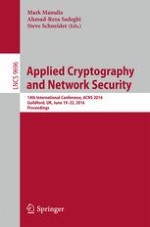2016 | OriginalPaper | Buchkapitel
Fuzzy Signatures: Relaxing Requirements and a New Construction
verfasst von : Takahiro Matsuda, Kenta Takahashi, Takao Murakami, Goichiro Hanaoka
Erschienen in: Applied Cryptography and Network Security
Aktivieren Sie unsere intelligente Suche, um passende Fachinhalte oder Patente zu finden.
Wählen Sie Textabschnitte aus um mit Künstlicher Intelligenz passenden Patente zu finden. powered by
Markieren Sie Textabschnitte, um KI-gestützt weitere passende Inhalte zu finden. powered by
